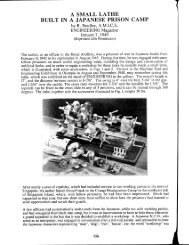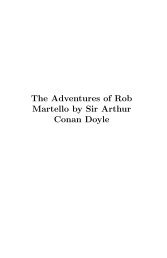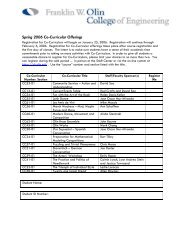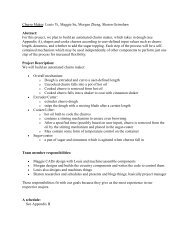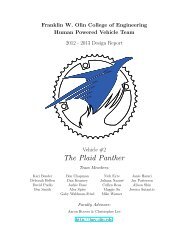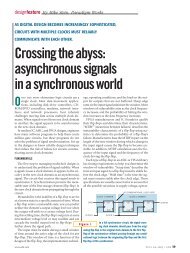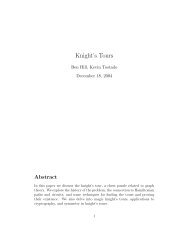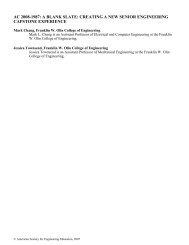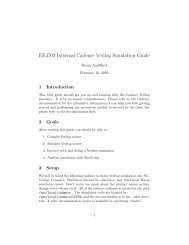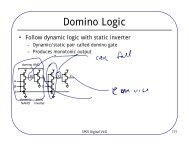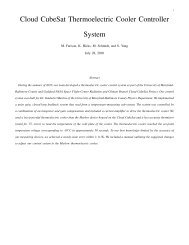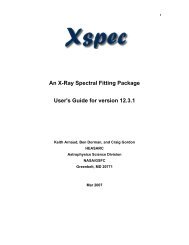Homework 3
Homework 3
Homework 3
You also want an ePaper? Increase the reach of your titles
YUMPU automatically turns print PDFs into web optimized ePapers that Google loves.
PAUL REVERE: TOUGH AS NAILS<br />
The Stuff of History + Materials Science and Solid State Chemistry<br />
<strong>Homework</strong> 3<br />
DUE FRIDAY, FEBRUARY 15, BY CLASS TIME (1 PM)<br />
THE “STUFF” OF HISTORY<br />
1. Read the description for the “Historical Research component of Project One on page 4 of the Assignments Supplement,<br />
especially points 6, 7, and 8.<br />
2. Read the description of the Paper one expectations, on pages 5-6 of the Assignments Supplement.<br />
3. Give your nearest friend a “high five” and have a soda, preferably of the root beer or vanilla coke persuasions (diet<br />
varieties are fine).<br />
4. Produce a “statement of goals” for this paper. You can write this as a coherent paragraph (which might end up as a part<br />
of your paper‘s introduction) or you can write it as a set of bullet points. Either way, make sure you cover the specific<br />
points you hope to address in this paper, which should include the following:<br />
a. Define and/or explain your modern artifact (in detail, including its cultural/social importance and its material<br />
properties)<br />
b. Define and/or explain your ancient counterpart (in detail, as above)<br />
c. Come up with a hypothesis that connects the modern and ancient counterparts<br />
d. Come up with a hypothesis that connects the item’s properties to its social and historical impacts<br />
5. Give your nearest friend a “high five with a flipside” and enjoy a small to medium sized chocolaty treat (frozen versions<br />
also acceptable).<br />
6. Produce a tentative outline for this paper. Use roman numerals and sub-items (i.e., I.A.1…), and go to whatever degree<br />
of detail that you can. Try to map out a coherent plan that takes you from an introduction through all of your material<br />
and historical evidence/arguments, to a conclusion. This outline needs to explicitly achieve your goals as stated in item<br />
three above.<br />
7. This one is optional, though it is included because it will help you. Try to insert the evidence (historical and scientific)<br />
you have gathered thus far into the outline. This evidence includes:<br />
a. Quotes, citations, paraphrasings, or statistics taken from your ancient civilization textbook<br />
b. Information from the Substance of Civilization<br />
c. Information from other sources in the library (historical atlases…)<br />
d. Information you researched in your answers to Exam One<br />
e. Materials science research information<br />
f. Materials science theory from your textbooks or other sources<br />
This exercise should help you evaluate your ability to write paper one. You may discover several gaping holes in your<br />
outline, in which case you can either change the emphasis of your paper or you can seek additional evidence.
M A T E R I A L S S C I E N C E<br />
READINGS<br />
o Crystallography. Callister Chapter 3 or Askeland Chapter 3 (Atomic and Ionic Arrangements). Read the entire<br />
chapter, but don’t spend too much time studying all those crystal structures in Sections 3.7 and 3.8.<br />
o Imperfections. Callister Chapter 4 or Askeland Chapter 4<br />
o Check out the crystal structure models in the library, if you have time.<br />
The key concepts in these sections are:<br />
Crystallography & Structure of Solids (Chapter 3)<br />
Single crystals, polycrystalline solids, and noncrystalline solids – What’s the difference?<br />
Lattice, crystal structure, lattice parameters (angles and edge lengths), unit cell concepts – Know what the unit cell<br />
represents, and be familiar with basic unit cell geometry.<br />
Crystal geometry – Be familiar with the terminology for crystallographic direction indices and planar indices (Miller<br />
indices), and be able to use direction indices and planar indices. For example, if you are asked a question about the<br />
(101) in bcc, you should be able to sketch the unit cell and identify the plane.<br />
Crystal structures. A lot of crystal structures are described in your textbook. You don’t need to memorize all<br />
these structures, of course, but be familiar with the more common metal structures (face centered cubic and body<br />
centered cubic). Be familiar with methods for determining the coordination number (number of nearest neighbors),<br />
and the number of atoms per unit cell.<br />
Atomic packing & density calculations – Why are these things important? They help us determine the properties of<br />
a material. For example, metals with higher packing factors and high symmetry, such as face centered cubic, tend to<br />
be much more ductile at lower temperatures than metals with lower packing factors or less symmetry.<br />
o Atomic packing factor (APF)<br />
o True density of a solid<br />
o Planar atomic density<br />
o Linear atomic density<br />
Polymorphs and allotropes. These are just fancy terms that refer to multiple solid forms of compounds<br />
(polymorphs) and elements (allotropes).<br />
X-ray diffraction. This is a good topic to spend some time understanding. In fact, Bragg’s law is on my top ten list of<br />
useful materials science equations. Take a look at how Bragg’s law is used in the determination of lattice parameters<br />
and analyzing x-ray diffraction patterns for crystalline substances. Also, check out the equation that relates<br />
interatomic spacing to the lattice parameter and Miller (planar) indices.<br />
Imperfections in Solids (Chapter 4)<br />
Defects topics tend to show up as parts of problems dealing with properties (e.g., mechanical or physical) and<br />
crystallography. For example, solubility limits are related to the atomic structures and bonding, and they are important<br />
in determining the strength or ductility of a material. The various types of defects can have different effects on<br />
mechanical properties of different materials.<br />
Differences in the scale and dimensions of 0-D (point), 1-D (line), 2-D (surface), and 3-D (volume) defects.<br />
Point defects are quite important in determining lots of material properties, including electrical, chemical, thermal<br />
and mechanical. Some examples:<br />
o Vacancies. How does the equilibrium number of vacant sites in a solid change as a function of temperature?<br />
o Impurities – substitutional (replace an atom in the crystal structure) and interstitial (squeeze an impurity into a<br />
smaller space between the normal atomic positions in a structure).<br />
o What factors that determine extent of solid-state solubility<br />
Line defects are very important for determining mechanical properties…dislocations slip through a material in<br />
response to applied stress. If we can stop the slip, we can strengthen and harden the material!<br />
o Edge and screw dislocations<br />
o Strain fields around an edge dislocation. How might these strained regions interact with other defects?<br />
Surface defects – external surfaces, grain boundaries, twin boundaries<br />
Volume defects – cracks, pores, voids, inclusions<br />
Importance of defects in determining mechanical behavior of ceramic materials
PROBLEMS<br />
Practice Problems<br />
1. Askeland Problem 3-34. Beryllium has a hexagonal crystal structure, with a o = 0.22858 nm and c o = 0.35842 nm. The<br />
atomic radius is 0.1143 nm, the density is 1.848 g/cm 3 , and the atomic weight is 9.01 g/mol. Determine<br />
a. The number of atoms in each unit cell; and<br />
b. The packing factor in the unit cell<br />
2. Askeland Problem 3-78. Explain why most often polycrystalline materials exhibit isotropic properties.<br />
3. Crystallographic planes. Sketch an fcc unit cell. Within the unit cell, sketch and label the following:<br />
a. ( 0 0 1 ) b. 2 0 1<br />
( ) c. [ 1 2 0]<br />
4. Crystallographic planes and directions. Sketch a bcc unit cell. Within the unit cell, sketch and label the following:<br />
a. [ 0 1 0 ] b. [ 2 2 1 ] c. ( 0 0 1 )<br />
5. Nickel has the fcc structure and a lattice parameter of a = 0.3517 nm.<br />
a. Determine the atomic radius in nm. Compare this value to that shown in the front of your textbook.<br />
b. Determine the atomic volume in nm 3 (assume a spherical atom shape).<br />
c. Determine the density in g/cm 3 and compare this answer to the Ni density value given in the table at the front<br />
of your textbook.<br />
6. Sketch an fcc unit cell.<br />
a. Determine the planar density for the ( 1 1 1 ).<br />
b. Determine the planar density for the ( 1 1 0 ).<br />
c. Determine the linear density for the [ 0 1 1 ]<br />
d. Determine the linear density for the [ 1 0 0 ].<br />
e. Given the densities you calculated for (a)-(d), which planes and directions would provide the easiest path for<br />
edge dislocation motion, or “slip”?<br />
7. The zinc blende (ZnS) structure is shown below.<br />
a. What is the coordination number for the Zn atoms?<br />
b. How many atoms per unit cell in the ZnS structure?<br />
8. Askeland 4-67. Why is most “gold” or “silver” jewelry made out of gold or silver alloyed with copper, i.e, what<br />
advantages does copper offer?
9. Solid state solubility. Of the elements in the chart below, name those that would form each of the following<br />
relationships with copper (non-metals only have atomic radii listed):<br />
a. Substitutional solid solution with complete solubility<br />
b. Substitutional solid solution of incomplete solubility<br />
c. An interstitial solid solution<br />
Element Atomic Radius (nm) Crystal Structure Electronegativity Valence<br />
Cu 0.1278 FCC 1.9 +2<br />
C 0.071<br />
H 0.046<br />
O 0.060<br />
Ag 0.1445 FCC 1.9 +1<br />
Al 0.1431 FCC 1.5 +3<br />
Co 0.1253 HCP 1.8 +2<br />
Cr 0.1249 BCC 1.6 +3<br />
Fe 0.1241 BCC 1.8 +2<br />
Ni 0.1246 FCC 1.8 +2<br />
Pd 0.1376 FCC 2.2 +2<br />
Pt 0.1387 FCC 2.2 +2<br />
Zn 0.1332 HCP 1.6 +2<br />
10. Vacancies. Calculate the fraction of atom sites that are vacant for pure lead at room temperature (25 °C) and at 310 °C<br />
(just below its melting temperature). The activation energy for vacancy formation is about 53 kJ/mole. How do you<br />
think the difference in the fraction of vacant sites will affect self-diffusion (diffusion of the atoms within their own crystal)?<br />
11. Strain fields around dislocations. Sketch the distortion of a crystal lattice around an edge dislocation, and show the<br />
preferred regions for (i) large substitutional atoms, (ii) small substitutional atoms, and (iii) interstitial atoms. HINT:<br />
Determine the type of distortion (tension or compression) that the large and small substitutional atoms will have on a<br />
perfect lattice, then think of how the distortion around a dislocation could best be balanced or relieved by the distortion<br />
caused by the substitutional atoms.<br />
Open-Ended Problems<br />
1. An unforeseeable reaction has just destroyed the metal lining of your high temperature vacuum furnace. You can’t afford<br />
to purchase a new lining, so you’ve decided to make a new lining in the Olin shop. The lining is basically a 6-inch metal<br />
cube with a wall thickness of 0.125 inches. One problem: you don’t know the material used for the furnace lining. You<br />
think you can safely assume it’s a pure metal, but other than that, you’re at a loss.<br />
To determine the unknown metal, you run a standard x-ray diffraction scan, the results of which are shown in the<br />
following figure. Crystallographic planes (hkl) are indexed on the pattern. The copper radiation used in the x-ray<br />
diffraction test had a wavelength of 0.1542 nm.
a. Given the XRD data, what is the likely crystal structure of the unknown metal?<br />
b. What is the lattice parameter of the unknown metal?<br />
c. Based on your answers in parts (a) and (b), which of the following materials is the most likely match for the<br />
unknown metal?<br />
i. Tantalum<br />
ii. Nickel<br />
iii. Sodium<br />
iv. Zirconium<br />
v. Tungsten<br />
vi. Chromium<br />
d. Will you be able to fabricate the material in the Olin machine shop? Briefly explain your answer.<br />
2. Noncrystalline SiO 2 is optically transparent. Polycrystalline SiO 2 is opaque or translucent. Single crystal SiO 2 is optically<br />
transparent. Explain.



